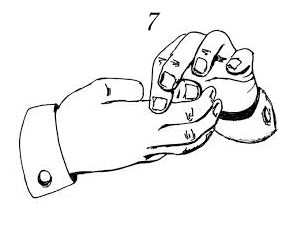 Despite what you may think, the seven types of tricky students don’t include grumpy, sleepy, cranky or dozy. However there are predictable types and once you learn to recognize them you can craftily develop cunning plans to engage them.
Despite what you may think, the seven types of tricky students don’t include grumpy, sleepy, cranky or dozy. However there are predictable types and once you learn to recognize them you can craftily develop cunning plans to engage them.
- The invisible worriers These kids master the art of invisibility. They go missing in action. You won’t hear a murmur from them. They won’t ask for help, aska question if they are confused or offer an answer if they know it. Wide eyed, they shun the spotlight and cringe if picked out from the crowd. One of the oldest parts of the brain called the basal ganglia is likely to be in overdrive. This brings with it vigilance, anxiety and feelings of being overwhelmed. The neurochemical surging through their brains is cortisol. The key to engaging the invisible worriers is to lower cortisol and the level of activity in the basal ganglia. Take your time- if you push things they clam up. Develop calm repetition in classrooms Remind students how something new relates to things they have already accomplished Meditation and focusing activities Mindfulness Theatre sports Challenges, quizzes, puzzles, Fermi questions. Rhythmic activities Hand warming Biofeedback games Concentration and memory games If you have a few invisible worriers in a class you may have to reduce small group work until they feel more confident.
- The defense attorneys Dispute? Complain? These kids will complain until the cows come home. The part of their brain that is running hot is the anterior cingulategyrus. These kids often have laser brain they get so focused on an idea or a dispute that can’t let it go. They don’t know when to stop. They get brain lock. Because they get brain locked they really don’t know how to let things go. This means that if you don’t change their direction they will battle on and on. At the first instance of a dispute, move these kids. The defense attorneys are often quite high on adrenaline and dopamine. They can be highly motivated especially when it comes to battles of wills. These kids can hold grudges for a long, long time. If you assert that the moon is blue they adamantly will say it is greenish. If you say, “you always seem to argue with me”. They’ll rely, “no I don’t!” The main way to engage defense attorneys is to lower their level of adrenaline while utilizing their dopamine. Movement is critical to engaging these students. They get so locked in mentally unless they have a physical shift they don’t change. Other strategies include: Devil’s advocate debates Out do your own argument Find what is wrong with this information games Spot the error Challenges and personal bests The tricky students are vulnerable to getting stuck. Their ideas go around and around in repetitive loops. Their behaviours are often repetitive. To shift these kids it is desirable to alter the scene, timing, and content of the dispute.
- It’s my way or I don’t play These kids are over-focused and rigid. This includes the perfectionists, the stickers for rules and the nitpickers. The pre-frontal cortex is likely to be in over-drive creating a focus on rules and being a stickler for details. Their behaviour often conceals an anxiety about not being able to structure the events in their world. The key to engaging these budding control freaks is to increase the use of tools that help them to structure. Planning Anticipation and prediction games Mazes Concentration games Ladders of understanding Scaffolding Music Increase their levels of dopamine using humour, challenges and puzzles.
- The Perpetually Disgruntled Everything is too much trouble for this group. Let’s sweat the big stuff the small stuff and middle sized stuff while we are at it. Students who get this often wake up in the middle of the night and can’t get back to sleep. Sleep disturbance is common. The emotional processer of the brain, the limbic system is often in over-drive. They are negative and stuck on being so The key to engaging the disgruntled is to help them step away from their own thoughts. Gratitude exercises Being the thinker behind the thoughts Evaluating different perspectives Thought stopping Challenges Humour Dopamine increasing activities- social interaction, repetitive Movements
- Listless do-littles These kids are like sloths- they don’t do much, they don’t say much, they don’t move much. They are motivationally deficient Despite their low energy for learning some of them manage to muster enough energy to be the court jesters of the class The key to engaging the listless do-nothings is to use activities that raise dopamine- social interaction. Humour, challenges and thought stopping6.
Ticking time bombs These kids stand out. They often have literacy problems and poor memory. Some of them misinterpret others’ actions as negatively intended. A few have white coal incendiary temper. The part of the brain is that is most likely involved are the temporal lobes. The key to engaging the ticking time bombs is exercise, movement and brain gym. Calming activities will also assist this group.
- The lights are on but….The lights are low nobody’s home. These are spacy, dreamy kids who often feel overwhelmed by the demands of school and life. Usually they have poor concentration and find it difficult to articulate their thoughts. These students often put off schoolwork until it is too late to complete it in time. They appear sluggish, tired and often complain of being chronically bored. Get a Wechsler Intelligence Scale for Children (WISC) completed if you have access to a psychologist. To get major shifts with the engagement of these students you will need to get parents working with you. Life-style issues such as diet, sleep, physical activity and lowering family stress are critical elements. It may also be important to organize a more stimulating environment for these students.
Hooks of Engagement
Greeting at the door
In English SRA activities DVDs, TV series Enacting, theatre sports Word sorts, puzzles Thematic activities Role play, dress ups Word of the day Books Cloze activitiesChatter box Readers theatre Parody Story cubes
This is material drawn from Andrew’s most recent book “TrickyTeens” (Finch Press,2014).
In Science
Doing an experiment Having the experimental ready set up Field trips Gadgets: digital microscopes, testing equipment Room set up: lab coats, specimens, posters, sensory stimulators Building set up Personnel technology You Tube Images PPT zoomed in Google pictures Gross things Big books Show and tell, Making things Squishy toys
In SOSE
Use an interesting letter(spies) as they walk in Plays, modeling, costumes Graphic organisers, flowcharts Reading groups Thinking hats Philosophy Mock trials Newspapers/news clips Bones in sandpit Forensic
In Mathematics
Engaging conversations Practical applications Brainteasers Perplexity in the classroom Mr. Meyerhttp://mysa13.mrmeyer.comSquare and Triangular Numbers Investigation Grades 3-7Mathematics games and activities: cards, blocks dominoes, dice Real world applications Hands on activities Mini whiteboards Group work rotations Surveys Background of formulas Maths jeopardy Volume and proportions snow/slime Angry Bird slingshot Super maths world Skittles counting sorting eating Terminator Blocks, tiles and dominoes
In History
Personal experience Showing “old stuff” Visiting sitesICT enhancement for example virtual sites Enactments Dress ups Theme days Horrible Histories On this day Models Word quizzes Fake book Movie clips
In Geography
Maps – making &creating Site visits Using technologyDVDs3D mapping, Google Earth Geoscience centre Post cards Foreign money Passport Newspaper articles YouTube TED Ed, Ted Talks SIM city
www.andrewfuller.com.au


